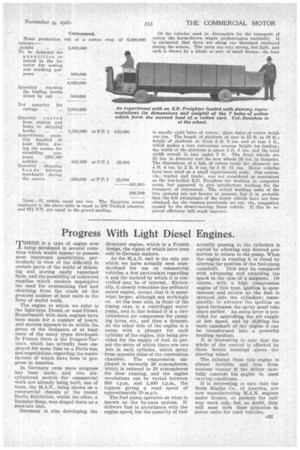Progress With Light Diesel Engines.
Page 89

If you've noticed an error in this article please click here to report it so we can fix it.
'THERE is a type of engine now 1 being developed in several countries which would appear to possess most important possibilities, particularly in view of the difficulty in certain parts of the world of obtaining and storing easily vaporized fuels, and the possibility of restricted supplies which renders imperative the need for economizing fuel and obtaining from the crude oil the greatest number of heat units in the form of useful work.
The engine to which we refer is the light-type Diesel or semi-Diesel. Experiments with such engines have been made for a number of years, and success appears to be within the grasp of the designers of at least some of the many types developedIn France there is the Peugeot-Tartrais, which has actually been employed for some time on a Paris bus, and negotiations regarding the manufacture of which have been in progress in America.
In Germany even more progress has been made, and two sixcylindered models for commercial work are already being built, one of them, the M.A.N., being shown on a commercial chassis at the recent Berlin Exhibition, whilst the other, a Daimler-Benz, was staged there as a separate unit.
Germany is also developing the
Montazet engine, which is a French design, the rights of which have been sold to German makers.
As the M.A.N. unit is the only one which we have actually seen standardized for use on commercial vehicles, a few particulars regarding it and the method by which it is controlled may be of interest. Externally it closely resembles the ordinary petrol engine, except that it is somewhat larger, although not strikingly so. At the near side, in front of the timing case, is a centrifugal water pump, and in line behind it is a twocylindered air compressor for pumping tyres, etc., and then a dynamo. At the other side of the engine is a pump with a plunger for each cylinder of the engine, this being provided for the supply of fuel, to permit the entry of which there are two jets in each cylinder, which spray from opposite sides of the combustion chamber. The compression employed is normally 28 atmospheres, which is reduced to 18 atmospheres for slow running, and the engine revolutions can be varied between 300 r.p.m. and 1,400 r.p.m., the highest giving a road speed of approximately 20 m.p.h.
The fuel pump operates on what is known as the by-pass system. It delivers fuel in accordance with the engine speed, but the quantity of fuel actually passing to the cylinders is varied by allowing any desired proportion to return to the pump. When the engine is running it is timed by altering the position of the fuel-pump camshaft. This may be compared • with advancing and retarding the spark in the case of a magneto. Of course,with. a high compression engine of this type, ignition is spontaneous and occurs as the fuel is sprayed into the cylinders ; consequently, to advance the ignition as speed increases, the spray must take place earlier. An extra lever is provided for controlling the air supply at low speed, and by shifting the main camshaft of the engine it can be transformed into a powerful braking medium.
It is interesting to note that the whole of the control is effected by three levers mounted above the steering wheel.
The exhaust from this engine is almost invisible and free from noxious vapour if the driver carefully controls his engine to meet varying conditions.
It is interesting to note that the I3uda Engine Co., of America, are now manufacturing M.A.N. engines under licence, at present for railway Work only, but, no doubt, they will soon turn their attention to power units for road vehicles.












































































































































































































